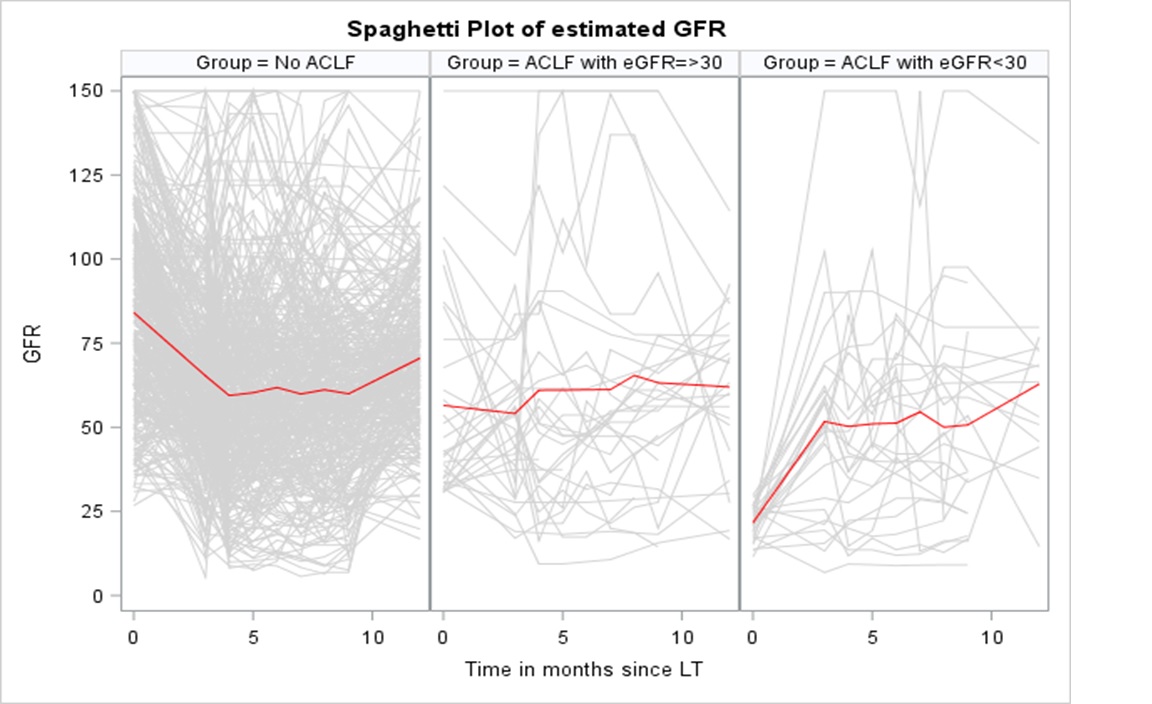Post-Transplant Renal Function in ACLF Patients Based on Pre-Transplant Severity of Renal Dysfunction without Kidney Transplant
1James D. Eason Transplant Institute, Methodist University Hospital, Memphis, TN, 2Division of Epidemiology, Biostatistics, and Environmental Health, The University of Memphis, Memphis, TN, 3Faith & Health Division, Methodist Le Bonheur Healthcare, Memphis, TN, 4Department of Medicine, University of Tennessee Health Science Center, Memphis, TN, 5Donald and Barbara Zucker School of Medicine at Hofstra/Northwell, Hempstead, NY, 6Sandra Atlas Bass Center for Liver Diseases & Transplantation, Department of Medicine, Northshore University Hospital/Northwell Health, Manhasset, NY
Meeting: 2020 American Transplant Congress
Abstract number: C-129
Keywords: Liver transplantation, Renal dysfunction, Renal function
Session Information
Session Name: Poster Session C: Liver - Kidney Issues in Liver Transplantation
Session Type: Poster Session
Date: Saturday, May 30, 2020
Session Time: 3:15pm-4:00pm
 Presentation Time: 3:30pm-4:00pm
Presentation Time: 3:30pm-4:00pm
Location: Virtual
*Purpose: It is unknown whether severity of renal dysfunction in ACLF patients impacts outcome of ACLF patients compared to those without ACLF.
*Methods: In a single center large retrospective study, we included 413 of 687 consecutive LT recipients. Recipients were analyzed in 3 groups: ACLF with Low GFR (A-LGFR) at LT (eGFR<30 mL/min;n=27); ACLF with High GFR(A-HGFR) (eGFR ≥30 mL/min;n=32); and those with no ACLF(n =354). The longitudinal data set with eGFR at transplant(0) and 3,4,5,6,7,8,9,12 months post-LT were evaluated. We assessed the association between ACLF and three kidney related outcomes:1) eGFR at baseline and 12 months,2) time to development of composite kidney outcome(eGFR<30 mL/min separated by ≥90 days or need for dialysis), and 3)association of pretransplant renal dysfunction(eGFR closet to LT) with the slope of renal function after LT by linear mixed model.
*Results: Mean age at LT was 54±9 years, 32% were female and 75% were Caucasian. Figure represents the eGFR over time by group with mean eGFR over time (red line).
A change in the slope for eGFR at 3 months after LT was noted in all three groups, with a decline in the non-ACLF group, and a statistically significant increase in the A-LGFR and the A-HGFR group(p<0.0001). After 3 months, eGFR in the LGFR group approached the baseline mean eGFR value of A-HGFR and non-ACLF groups. The difference between the eGFR slope before 3 months and after 3 months was significant in non-ACLF and A-LGFR groups (p<0.0001), but not in the A-HGFR group after adjusting for confounders.EGFR at LT (4±29 vs 84±29 ml/min, p<0.001), 3 months after LT (54±29 vs 65±26 ml/min, p<0.001), and 12 months (59±23 vs 71±24 ml/min, p=0.001) were significantly lower in the ACLF group compared to non-ACLF group.
*Conclusions: Patients with ACLF have significantly lower eGFRs at 12 months follow up compared to the non-ACLF group. However, the trajectory of eGFR slope and time to composite kidney outcome were not different at 12 months.
To cite this abstract in AMA style:
Yazawa M, Maliakkal B, Nair S, Jiang Y, Podila PS, Agbim UA, Karri S, Khan SD, Maluf D, Eason JD, Molnar MZ, Satapathy SK. Post-Transplant Renal Function in ACLF Patients Based on Pre-Transplant Severity of Renal Dysfunction without Kidney Transplant [abstract]. Am J Transplant. 2020; 20 (suppl 3). https://atcmeetingabstracts.com/abstract/post-transplant-renal-function-in-aclf-patients-based-on-pre-transplant-severity-of-renal-dysfunction-without-kidney-transplant/. Accessed December 26, 2025.« Back to 2020 American Transplant Congress

